Optimizing Performance for a Collision/Reaction Cell ICP-MS System Operating in Helium Collision Mode
Almost all current quadrupole ICP-MS systems use collision/reaction cell technology to reduce polyatomic interferences, but the effectiveness of these devices for the removal of unexpected interferences remains a contentious issue. Here, we demonstrate that helium cell mode operation on the instrument described provides an opportunity for analysts to report reliable multielement data from complex, variable, and unknown matrices, using a single He mode method for all required analytes.
The rapid acceptance of collision and reaction cell technology in quadrupole inductively coupled plasma-mass spectrometry (ICP-MS) is an indication of the dramatic improvements that can be obtained in the analysis of interfered elements, which previously proved difficult to analyze at the required levels in certain sample matrices. However, it has been pointed out (1,2) that many of the early reported applications of collision/reaction cell ICP-MS focused on the removal of single interfering species from single analytes (3–10).
For many routine laboratories, one of the main attractions of ICP-MS is its simple operation for multielement analysis. However, the potential for the multielement capability of ICP-MS to be utilized in combination with collision/reaction cell conditions has been a relatively understudied area (11), with routine analysis of variable sample matrices being even less widely investigated (1).
Some more recent ICP-MS applications development studies have involved further investigation into the range of specific single-element, single-matrix interferences that can be addressed using specific reaction gases and specific cell conditions (12–14). However, such applications are of limited relevance in most working laboratories, so some workers have focused on the maintenance of the multielement capability of the ICP-MS system in combination with the removal of multiple matrix-based interferences in complex sample matrices. This more accurately reflects the requirements of routine analytical laboratories, where the composition of the samples is typically unknown, time is not available for specific method development for each sample or each analyte, and consistent instrument conditions are used for all sample types.
By comparing the mass spectra obtained with no cell gas and a single set of helium (He) mode conditions, the removal of multiple interferences was investigated in a complex matrix containing 5% HNO3, 5% HCl, 1% H2SO4, and 1% propan-2-ol (IPA). These matrix components (N, Cl, S, and C) were chosen because they represent common sample constituents and are each known to result in problematic polyatomic interferences in the mass range 44 amu to 81 amu. All isotopes of all elements in this mass range were measured, covering the preferred isotopes of Sc, Ti, V, Cr, Mn, Fe, Co, Ni, Cu, Zn, Ga, Ge, As, and Se, which are among the most interfered elements typically measured by ICP-MS. The effectiveness of He mode in reducing all interferences in this mass range was evaluated, and maintenance of good ion transmission was confirmed by analysis of all elements in this mass range in a spike at 10 ng/mL in the same matrix.
This spectrum comparison demonstrates the applicability of He mode with kinetic energy discrimination (KED) for multielement analysis of elements at the low parts-per-billion (nanogram-per-milliliter) levels typically measured in many common applications, such as environmental monitoring and food safety applications. However, in some cases certain analytes (notably Fe, Se, P, and S, which suffer from intense plasma-based interferences) must be measured at lower levels than is possible using conventional He mode. A recent refinement of the cell used in ICP-MS instruments (such as the 7700 Series, Agilent Technologies, Santa Clara, California) has resulted in a dramatic improvement in the He mode detection limits that can be achieved for these previously difficult elements by using modified conditions with higher cell gas pressure and higher energy discrimination voltages.
Method
Optimization of cell conditions: This work investigated the interference removal capability of an ICP-MS instrument (7700 Series, Agilent). The general configuration of the instrument utilized has been described previously (15), except for the recent introduction of an off-axis ion lens configuration, situated in front of the collision/reaction cell, which in turn is on-axis with respect to the quadrupole. The instrument was operated in both no-gas mode and collision mode using He cell gas and kinetic energy discrimination (KED) to evaluate the removal of multiple unknown matrix-based polyatomic ion interferences.
As has been noted in previous publications (16,17), this mode of interference removal relies upon good control of ion energies to permit effective separation of the analyte and interferences. The removal of polyatomic interferences by kinetic energy discrimination is illustrated in Figure 1, which shows how analytes and polyatomic ions can be separated due to their differential rates of collision, since the polyatomic (or molecular) ions have a larger ionic cross section than the analyte ion of the same mass, and therefore collide more frequently with the cell gas. The efficiency of this separation is improved when the ions enter the cell with a narrow initial ion energy spread.
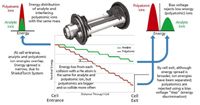
Figure 1: Principle of operation of helium mode with kinetic energy discrimination in the Agilent 7700x Octopole Cell (ORS3).
It also has been shown that any contamination of the cell by reactive gases leads to the interference removal (together with the concomitant loss of analytes and formation of new polyatomic species) being dominated by reaction processes (19), which makes reactive cell gases largely unsuited to multielement determinations in variable matrix samples. For this reason, pure He (Premier Quality - 99.9992% He, Air Products, Crewe, UK) was used throughout these studies.
General instrument conditions: The instrument was optimized in accordance with the manufacturer's recommendations (optimized for <1% CeO/Ce), and the operating conditions are summarized in Table I.
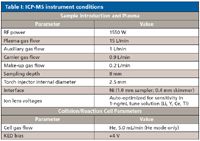
Table I: ICP-MS instrument conditions
To investigate whether a single set of conditions could provide effective interference removal for multiple analytes in a complex matrix, the gas flow rate and cell voltages were not optimized specifically for any of the elements of interest or any of the possible interferences likely to arise from the mixed matrix being studied. This approach was used to illustrate the simple method development that is characteristic of He mode, and it is representative of the limited information that would be available in a routine laboratory, when detailed information on the actual matrix composition of each sample typically is not available.
The general approach to the removal of polyatomic ions using He cell gas and kinetic energy discrimination has been discussed elsewhere (2,7) and the previously established He flow rate and KED voltages were used for this work (5-mL/min He cell gas flow and 4-V energy discrimination).
Reagents used for matrix interference tests: Table II summarizes the range of polyatomic interferences that might be derived from a typical complex sample found in many laboratories. In this case, the synthetic matrix contained 5% HNO3, 5% HCl, and 1% H2SO4 (all UpA UltraPure Reagents, Romil, Cambridge, UK), and 1% IPA (SpS Super Purity, Romil, Cambridge, UK). All reagents were prepared by v/v dilution using deionized water from a MilliQ Element deionizer (Millipore, Billerica, Massachusetts). All sample matrix components were mixed in a single solution, which was then analyzed on the instrument using an acquisition method that switched automatically between He mode (one set of conditions for all samples and all analytes) and no-cell-gas mode (one set of conditions for all samples and all analytes).

Table II: Principal polyatomic interferences from matrix containingN, Cl, S, and C
Results and Discussion
Comparison of background spectra: The background spectra for the mixed matrix in no-cell-gas mode and He mode are shown in Figures 2a and 2b (same mass range and intensity scale).
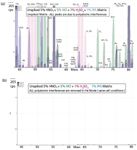
Figure 2: High matrix sample (see inset text for matrix composition and color key) in (a) no-cell-gas mode and (b) He cell gas mode (same scale as used for Figure 2a).
The combination of plasma background ions (due to the argon and components of the aqueous sample solution [Ar, O, H]), and the additional components of the matrix sample (N, Cl, S, and C from the 5% HNO3, 5% HCl, 1% H2SO4, and 1% IPA matrix), led to the formation of numerous interfering polyatomic ions in no-gas mode (see Figure 2a). In this spectrum, the peak color indicates which matrix gave rise to each polyatomic ion, and it is apparent that in many cases, multiple polyatomic ions from different matrix components overlap the same analyte mass. The highest intensity peaks were ArO+ (m/z 56) and Ar2+ (m/z 80) from the plasma, and CO2+ (m/z 44), SO+ (m/z 48, 49, 50), ClO+ (m/z 51, 53), ArC+ (m/z 52), SO2+ and S2+ (m/z 64, 65, 66, 67), Cl2+ (m/z 70, 72, 74), and ArCl+ (m/z 75, 76) from the matrix. However, it is clear that almost all masses in this region of the spectrum suffered interference from at least one polyatomic ion, confirming the presence of many of the potential interferences listed in Table II. Many of these matrix-derived interferences have the potential to cause errors in routine sample analysis, due to the fact that their occurrence and intensity are dependent upon the matrix composition, which is not typically known or constant.
Clearly, the presence of the interferences shown in Figure 2a would make it difficult to provide reliable quantification of many of these trace elements, especially if the matrix composition changed from one sample to another. It is for this reason that many workers have had to rely upon empirically derived and maintained interference correction equations (20), which can introduce errors if an unexpected matrix component occurs on one of the intermediate masses used in the correction. Furthermore, in routine laboratories, it typically is not possible to spend a large amount of time characterizing and updating the required corrections for the large and variable set of potential matrix interferences.
Figure 2b shows the mass spectrum for the same matrix measured using standard He-mode collision conditions, at the same scale as shown in Figure 2a. Under He-mode conditions, all of these polyatomic background peaks were removed from the spectrum. Remaining trace-level signals are due to analyte contaminants in the matrix components as validated by the fact that the measured peaks fit the theoretical isotopic templates for the elements.
Measurement of analytes in the presence of the sample matrix: Having demonstrated the effective reduction of the wide range of plasma-based and matrix-based polyatomic species, under a single set of He-mode cell conditions (Figures 2a and 2b), a second sample was analyzed, consisting of the same multicomponent matrix, spiked with a multielement standard (Figure 3). The standard was measured to check that the same cell conditions used for interference removal also gave sufficient analyte sensitivity to permit the analysis of the trace elements in this mass range. The spike consisted of Sc, Ti, V, Cr, Mn, Fe, Co, Ni, Cu, Zn, Ga, Ge, As, and Se, each at 10 ng/mL. All of these elements had at least one analytically useful isotope that suffered a polyatomic overlap in no gas mode in this matrix. The spectra in Figure 3 are overlaid with isotopic ratio templates demonstrating that not only are the interferences removed, but that they are removed consistently from all isotopes resulting in isotopic patterns that match the theoretically correct ratios.
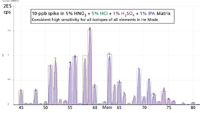
Figure 3: Spiked high matrix sample (10 ng/mL Sc, Ti, V, Cr, Mn, Fe, Co, Ni, Cu, Zn, Ga, Ge, As, and Se) in He cell gas mode (same scale as used in Figure 2).
The acquisition of scan spectra used in this work illustrates the effective removal of multiple potential interferences from multiple analyte isotopes under a single set of He-mode cell conditions. In addition, full scan, interference-free spectra allow the detection of unexpected elements by semiquantitative screening of unknown samples by ICP-MS. Furthermore, the ability to remove all interferences on all analyte isotopes is a useful function in a wide range of applications where the measurement of one single "preferred" isotope for each analyte provides insufficient information.
These applications include:
- The use of secondary isotopes to confirm the measurement made at the primary isotope (equivalent to the use of qualifier ions in organic mass spectrometry).
- The facility to switch to an alternative isotope that would normally be avoided due to a potential polyatomic overlap (such as 63 Cu/40 Ar23 Na), to extend the measurement range.
- The use of stable isotope markers or tracers, where both the natural isotope and the stable isotope spike must be measured free from interference.
- The use of isotope dilution calibration where, again, both natural and spike isotopes must be free from interference.
Optimizing Efficiency of KED for the Removal of High-Intensity Backgrounds: If lower level analysis of severely interfered elements such as Se, Fe, S, and P is required, the normal He-mode conditions outlined earlier cannot always provide sufficient reduction of the intense plasma-based interferences on these elements. Previously, these elements would have been measured using reactive cell gases such as H2, using an additional cell gas step. The new cell design of the system discussed here (the ORS3 ) can be operated with a higher cell gas flow rate and bias voltage than its predecessor (the ORS2 ). This has the effect of further reducing the overlap between the residual kinetic energies of the polyatomic and analyte ions at the cell exit, thereby allowing more efficient separation between the two groups of ions. The principle of operation of this high flow rate and high ion energy separation in the ORS3 is illustrated in Figure 4 for the removal of the Ar2 interference on 78 Se.
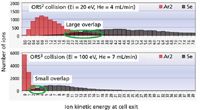
Figure 4: Cell exit ion energy profiles for ORS2 He mode (upper plot) and enhanced ORS3 He mode on the Agilent 7700x ICP-MS system (lower plot).
It is apparent from the residual (cell exit) ion energy distribution profiles that the modified operating conditions provided by the ORS3 deliver significantly higher ion transmission, while promoting better separation between the analyte ions and the interfering polyatomic ions. The net effect is an improvement in the 78 Se background equivalent concentration (BEC) in He mode from about 140 ng/L (parts per trillion) on the previous ORS, to about 4 ng/L on the ORS3 . The cell gas flow rate calibration for this ion pair (Ar2/Se) is shown in Figure 5. Note that the ion intensity is plotted on a log scale.
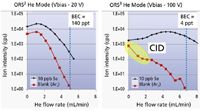
Figure 5: Cell gas flow rate vs. signal profiles for Ar2/Se with ORS2 (left) and ORS3 (right).
Figure 5 illustrates another beneficial aspect of He-mode operation on the ORS3 . In this profile (right), there is a steep initial reduction in the intensity of the Ar2 ion at low He flow rate, in contrast to the level or slightly increasing signal seen on the previous ORS2 . This steep reduction in signal is due to the promotion of collisional dissociation of the Ar2 molecular ion, due to the higher collision energy when operating under the new ORS3 conditions. The dissociation energy of the Ar2 ion is 1.33 eV, which is higher than the center of mass collision energy in conventional He mode (collision energy of 0.98 eV at an ion energy of 20 V), but lower than the collision energy in ORS3 He mode (collision energy of 4.88 eV at an ion energy of 100 V). As a result of this higher collisional energy, significant reduction in Ar2 (about an additional order of magnitude on top of the reduction due to KED) is achieved through dissociation of Ar2+ to Ar+ + Ar, with no concurrent loss of Se sensitivity.
Conclusion
The use of He-only cell gas mode has been demonstrated to provide effective removal of multiple polyatomic interferences in a complex matrix, so supporting multielement ICP-MS analysis. The use of an inert cell gas ensures that all polyatomics are reduced (not just reactive polyatomics), causes no reactive loss of analyte signal, and eliminates the generation of new interfering species.
He mode is suitable for almost all analytes that suffer from polyatomic ion interferences, and it can be applied to virtually any sample matrix without requiring extensive method development. These factors permit the use of a single set of analytical conditions for multiple analytes in many different sample matrices and, for the first time, allow ICP-MS to operate in the analysis of multiple potentially interfered analytes in high and variable matrices, without the need for any interference correction equations.
For those elements where low level analysis is precluded due to the presence of intense plasma-based polyatomic interferences, the new ORS3 also permits the more efficient removal of such interferences, using high flow and high ion energy conditions that deliver more effective separation of analyte and interfering ions. These ORS3 conditions also promote the dissociation of several polyatomic ions, further improving the background equivalent concentration for critical trace elements, and allowing these elements to be measured at low nanogram-per-liter levels using He cell gas, another first for ICP-MS.
Ed McCurdy, Naoki Sugiyama, and Steven M. Wilbur are with Agilent Technologies, Santa Clara, California.
References
(1) P. Heitland and H.D. Koster, J. Anal. Atom. Spectrom. 19, 1552 (2004).
(2) E. McCurdy and G. Woods, J. Anal. Atom. Spectrom. 19, 607 (2004).
(3) G.K. Koyanagi, V.I. Baranov, S.D. Tanner, and D.K. Bohme J. Anal. Atom. Spectrom. 15, 1207 (2000).
(4) P.R.D. Mason, K. Kaspers, and M.J. van Bergen, J. Anal. Atom. Spectrom. 14, 1067 (1999).
(5) J.M. Marchante Gayon, I. Feldmann, C. Thomas, and N. Jakubowski, J. Anal. Atom. Spectrom. 16, 457 (2000).
(6) E.H. Larsen, J. Sloth, M. Hansen, and S. Moesgaard, J. Anal. Atom. Spectrom. 18, 310 (2003).
(7) H-T. Liu and S-J. Jiang, Anal. Bioanal. Chem. 375, 306 (2003).
(8) D.R. Bandura, S.D. Tanner, V.I. Baranov, G.K. Koyanagi, V.V. Lavrov, and D.K. Bohme, in Plasma Source Mass Spectrometry: The New Millennium, G. Holland and S. D. Tanner, Eds. (The Royal Society of Chemistry, Cambridge, 2001), p. 130.
(9) C. Chery, K. DeCremer, R. Cornelis, F. Vanhaecke, and L. Moens, J. Anal. Atom. Spectrom. 18, 1113 (2003).
(10) F. Vanhaecke, L. Balcaen, I. Deconinck, I. De Schrijver, C.M. Almeida, and L. Moens, J. Anal. Atom. Spectrom. 18, 1060 (2003).
(11) M. Iglesias, N. Gilon, E. Poussel, and J-M. Mermet, J. Anal. Atom. Spectrom. 17, 1240 (2002).
(12) S.D. Tanner, V.I. Baranov, and D.R. Bandura, Spectrochim Acta Part B 57, 1361–1452 (2002).
(13) V.F. Taylor, R.D. Evans, and R.J. Comett, Anal. Bioanal. Chem. 387, 343–350 (2007).
(14) D.R. Bandura, V.I. Baranov, A.E. Litherland, and S.D. Tanner, Int. J. Mass Spectrom. 255–256, 312–327 (2006).
(15) P. Leonhard, R. Pepelnik, A. Prange, N. Yamada, and T. Yamada, J. Anal. Atom. Spectrom. 17, 189 (2002).
(16) M.A. Dexter, H.J. Reid, and B L. Sharp, J. Anal. Atom. Spectrom. 17, 676 (2002).
(17) N. Yamada, J. Takahashi, and K. Sakata, J. Anal. Atom. Spectrom. 17, 1213 (2002).
(18) K. Sakata and K. Kawabata, Spectrochim. Acta Part B 49, 1027–1038 (1994).
(19) M.A. Dexter, P.K. Appleblad, C.P. Ingle, J.H. Batey, H.J. Reid, and B.L. Sharp, J. Anal. Atom. Spectrom. 17, 183 (2002).
(20) J.L.M. de Boer, J. Anal. Atom. Spectrom. 15, 1157 (2000).

High-Speed Laser MS for Precise, Prep-Free Environmental Particle Tracking
April 21st 2025Scientists at Oak Ridge National Laboratory have demonstrated that a fast, laser-based mass spectrometry method—LA-ICP-TOF-MS—can accurately detect and identify airborne environmental particles, including toxic metal particles like ruthenium, without the need for complex sample preparation. The work offers a breakthrough in rapid, high-resolution analysis of environmental pollutants.
Trending on Spectroscopy: The Top Content of 2024
December 30th 2024In 2024, we launched multiple content series, covered major conferences, presented two awards, and continued our monthly Analytically Speaking episodes. Below, you'll find a selection of the most popular content from Spectroscopy over the past year.